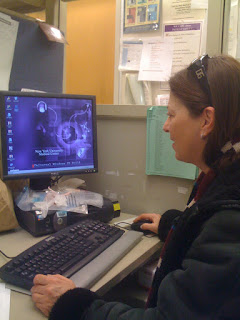Good news (so far). The donor coordinator called and said my blood passed the test for donation. A package of instructions will be coming in the mail soon that describes the next step. I do know that the next step involves evaluating my health and being healthy enough to donate as well as protecting the recipient from any disease/virus I may carry.
Will keep you posted. :-)
We are now Hawaiians - (well, sort of). Keep Hawaii Country - No more hotels please! Preserve native lands and resources. ENOUGH ALREADY!
Thursday, January 29, 2009
Monday, January 19, 2009
Donating a Kidney - A Journey

The first step in the kidney donation process is receiving a box. The box contains many papers - a medical history form, a letter of instruction for the blood lab, consent forms, Notice of Privacy Practices, a description of the process.

Here you can see the inside of the box (before being filled with the required amount of blood). If the potential recipient is not in the immediate area where the blood is collected the box is FedEx'd overnight to the donor coordinator associated with the potential recipient.

The plot thickens a little bit at this point for me. The date designated for collection (by the donor coordinator) is today - Martin Luther King Day. Everyone is closed. Anticipating a potential problem yesterday I called commercial labs as well as outpatient labs in 4 hospitals. All closed. With no other option we could think of John and I went to the Emergency Room at New York University Hospital. Unfortunately not many people are familiar with the screening process for live kidney donation (versus one donated by a cadaver). Come back Tuesday, come back Tuesday, come back Tuesday. . . can't tell you how many times we heard that phrase. Then an angel was called in to help sort out the situation. She was the Nurse Administrator on duty. After talking for a while and reviewing the paperwork the lady in this photo was paged. Her name is Peggy and she is a manager in the NYU outpatient lab. Wow - two angels in one day. Peggy knew that in addition to the lab work we would need a blood pressure reading among other measurements. We were sitting in the lobby of the main entrance to the hospital and the next thing I knew the third angel showed up pulling a blood pressure machine on wheels beside her. Wow. Then Peggy walked me to the blood lab. In this photo she is putting me into the NYU hospital system. I don't think I could have received better treatment if I was a VIP.

This is the lady who actually took the blood (and she is a pro - it did not hurt a bit).
The process from here, once the box is delivered to the recipient's hospital is described as:
1. An acceptable blood match starts the procedure - luckily I am a type O and can match any other blood type
2. Determining tissue compatibility with the recipient. The test of tissue compatibility is called a "crossmatch." It involves combining live white blood cells from the potential donor with the fluid part of the recipient's blood, called the "serum." Some recipients have special proteins in their blood that attack foreign cells. If the recipient's serum kills the donor's white blood cells, the crossmatch is called "positive." This means there was a positive killing of the potential donor's cells. In this case the transplant cannot be done and the screening ends. If there is no killing of my cells then we can move on to the next steps.
3. If number two (above) is OK then comes the matching of antigens. Human Leukocyte Antigens (HLA) are proteins on white blood cells. Each person has 6 different antigens. 3 are inherited from each parent, making a total of 6 antigens. The 6 antigens of the donor are compared to the 6 antigens of the recipient, and the "match" is determined. There does not have to be any matching antigens with the recipient to be a suitable donor. The "crossmatch" is actually more important than the "antigen match".
This is as far as we have gone this far. FedEx should deliver the box tomorrow.
Results should be called to me in about 5 days. Will keep you posted.
Subscribe to:
Posts (Atom)